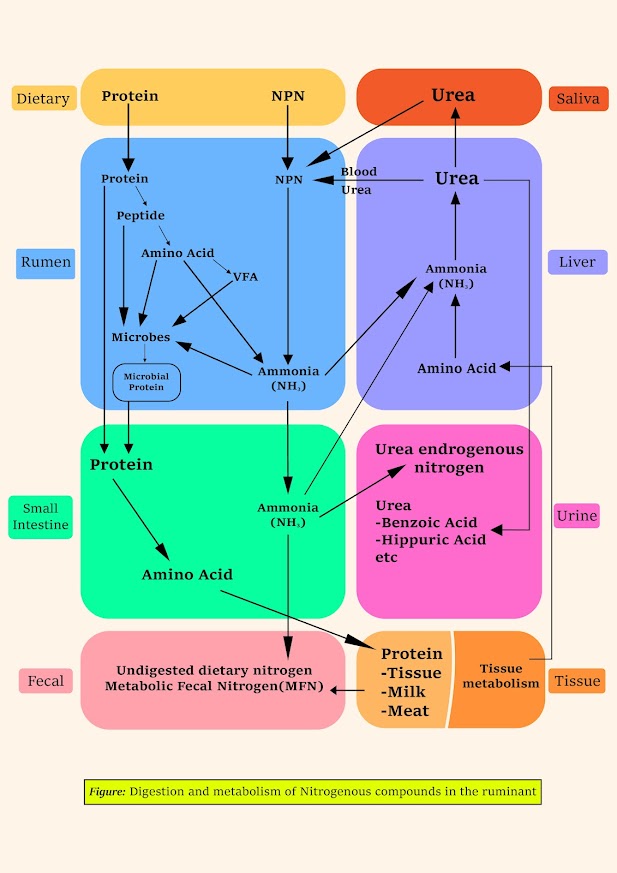Digestion of protein in ruminant
Digestion of protein in ruminant
The digestion of proteins in ruminants is different than non-ruminants. Food proteins are hydrolysed to
peptides and amino acids by rumen microorganism, but some amino acids are degraded further by
deamination to organic acids, ammonia (NH3) and carbon dioxide (CO2).
The main proteolytic organism is Prevotella ruminicola, Pepto-streptococci species and the protozoa. The ammonia produced together with some small peptides and free amino acids, is utilized by the rumen organisms to synthesis microbial proteins. Some of the microbial protein is broken down in the rumen and its nitrogen is recycled.
When the organisms are carried through to the abomasums and small intestine their cell proteins are digested and absorbed. An important feature of the formation of microbial protein is that bacteria are capable of synthesizing indespesable as well as dispensable amino acids, thus rendering their host independent of dietary supplies of the former. The greater part and sometimes all of the protein reaching the ruminant’s small intestine will be microbial protein of reasonably constant composition. The lesser part will be undegraded food protein which will vary in amino acid composition according to the nature of the diet. The NH3 in the rumen liquor is the key intermediate in the microbial degradation and synthesis of protein. If the diet is deficient in protein or if protein resists degradation the concentration of the rumen ammonia will be low about 50mg/litre and the growth of the rumen organisms will be slow; in consequence, the breakdown of carbohydrates will be retarded.
On the other hand, if protein degradation proceeds more rapidly than synthesis, ammonia will
accumulate in rumen liquor and the optimum concentration will be exceeded. When this happens
ammonia is absorbed into the blood through the ruminal wall, carried to the liver and converted to
urea. Some of this urea may be returned to the rumen via the saliva and also directly through the
ruminal wall, but the greater part is excreted in the urine and thus wasted. The proportion of the dietary
protein hydrolysed in the rumen depends on number of factors like solubility of proteins, quality of
proteins etc. On a normal diet about 50-60% of protein is attacked by microorganisms. The life of
microorganisms are very short, they are continuously flowing along with partially digested feeds
through the gastrointestinal tract in profuse amounts. In this way several billion dead microbes are
brought to the abomasums, where like in monogastric animals, proteolytic enzymes are secreted by the
numerous glands of abomasum and as they reach the small intestine pancreatic secretion and the
proteolytic enzymes of the small intestine present in brush boarded of epithelial walls act on these dead microbes and bring about a complete protein digestion resulting in amino acids as end products. Due to
peristaltic movement the abomasal contents enter the duodenum and jejunum. Here the pancreatic
digestive juices which contain zymogens; chymotrypsinogen and trypsinogen as well as procarboxy
peptidase gets activated resulting into chymotrypsin, trypsin and carboxy peptidase. All these enzymes
have a broad range of hydrolytic capabilities of protein. Intestinal secretion of dipeptidase hydrolyzes
dipeptides to liberate individual amino acids.
Absorption of amino acids:
For absorption of amino acids there are four distinct carrier systems situated throughout the microvilli
of the small intestine viz.
1. Neutral amino acids
2. Basic amino acids
3. Acidic amino acids and
4. Glycine and imino acids.
Absorption of individual amino acids into the mucosal cell from the lumen is associated with
absorption of Na+ from the serosal surface. These amino acids are then absorbed through the microvilli
of the small intestine for growth, tissue repair, and maintenance of the body protein reserves and for
products like milk etc.
Utilization of NPN compounds by the ruminants
Dietary protein is not the only contributor to the NH3 pool in the rumen. As much as 30% of the
nitrogen in ruminant food may be in the form of simple organic compounds such as nitrate. Most of
these are readily degraded in the rumen, their N entering the ammonia pool.
Urea is NPN that may be used as a protein replacer. Several studies have shown that urea can replace
satisfactorily up to about 30% of the protein in practical rations for matured ruminants and lactating
cows. This means that urea can be added at the rate of 3% of the concentrate mixture. For the efficient
utilization of urea simultaneous feeding of soluble carbohydrate, preferably of starch at the rate of 1 kg
for every 100g of urea is a must for the sake of providing necessary energy requirement of the
microbes. Although urea provides an acceptable protein source, there evidence that where it forms a
major part of dietary nitrogen, deficiencies of the sulphur containing amino acids may occur. In such
cases supplementation of the diet with a sulphur source may be necessary. An allowance of 0.13g of
anhydrous sodium sulphate per gram of urea is generally considered to be optimal. Many factors
influence the quantity of urea which can be utilized by ruminants. Among those of much importance
are the quality and quantity of CHO in ration. Maize and starch improve the urea nitrogen utilization. It
has further been established that heat processing of cereals intensifies to starch susceptibility to ∞-
amylase and improves the urea utilization by rumen flora. Large starch granules, such as are found in
certain varieties of tropical tubes, also reduce the rate of urea utilization. This can be improved by heat
processing. The quantity and quality of protein in the diet also influence the urea utilization.
How urea is utilized by ruminants
Urea urease from microbes NH3 +CO2
Carbohydrates enzymes from rumen microbes VFA + keto acids
NH3 + keto acids enzymes from microbes Amino acids
Amino acids enzymes from microbes Microbial protein
Microbial protein enzymes from abomasum Free amino acid
and small intestine
Free amino acids absorbed from small intestine for building body protein in the ruminants.
Factors essential for optimum use of urea:
1. Mix the urea thoroughly
2. Feed the urea only to mature cattle, buffalo, sheep and goat
3. Provide a readily available energy source, such as molasses or starch or grain
4. Supply adequate and balanced level of minerals and vitamin
5. Accustom animals gradually to urea containing feeds ( over a period of 5 to 7 days), fed at
equal interval
6. Limit the intake of urea to recommended maximum level as below-
Sheep: 1% of the DM in the ration or 1/3 of the total N in the ration or 3% of the concentrate
portion
Beef cattle: Urea may constitute up to 1/3 of the total protein of the ration
Dairy cow: Lactating cow producing less than 20 litres of milk per day, urea could constitute
up to 2% of the concentrate mixture or up to 1% of the total hay. It was further recommended
that no more than 1/3 of the protein requirement be met through the use of urea. For lactating
cows yielding more than 20 litres of milk urea should not be fed. At this level of production,
the microbes unable to synthesis enough protein to meet the needs, thereby placing a premium
on dietary protein which escapes ruminal fermentation. Bulls, heifers and low producing cow:
1.5 to 2% of the concentrate mixture may be used as urea.



Comments
Post a Comment